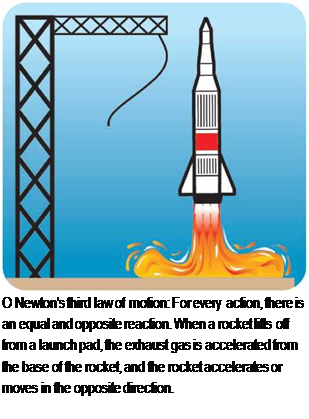Second Law
The second of Newton’s laws explains how the motion of an object changes when a force acts on it. It says that the rate of change of an object’s momentum (which is its mass multiplied by its velocity) depends on the size of the force acting on the object.
If a force acts on a mass for a period of time, it produces a change in velocity. A change in velocity is the same as acceleration. Newton’s second law can be written as: Force = mass x acceleration. The bigger the force acting on an object, the faster it accelerates.
The connection between force and acceleration works in either direction. Force produces acceleration, and acceleration produces force. The thrust of an airliner’s engines makes the plane accelerate along a runway for takeoff. This is an example of force producing acceleration. Inside the airplane, the passengers feel themselves being pushed back in their seats. This is an example of acceleration producing force.
Usually, more than one force acts on an object. When two or more forces act
|
Lighter car, larger engine |
О Newton’s second law of motion: When different forces act upon the same mass, more force produces more acceleration. When the same force acts upon different masses, the greater mass accelerates less. So the racecar with the larger engine (more force) will accelerate faster than the same racecar with a smaller engine. But the lighter racecar will accelerate faster than the heavier racecar (more mass) with the same size engine.
 in the same direction, they combine to produce a stronger force. This is called the resultant force. When forces act in opposite directions, the resultant force is the difference between them. If the resultant force acting on a mass is not zero, it produces acceleration.
in the same direction, they combine to produce a stronger force. This is called the resultant force. When forces act in opposite directions, the resultant force is the difference between them. If the resultant force acting on a mass is not zero, it produces acceleration.











